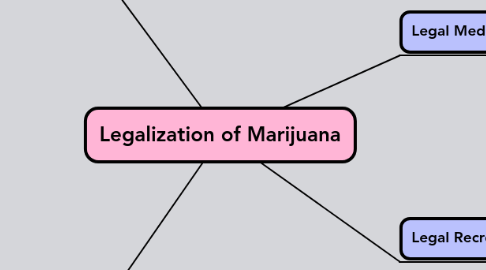
1. War on Drugs
1.1. Anti-Drug Acts
1.1.1. Anti-Drug Abuse Act of 1988 makes life without parole the sentence for offenders who are on their third strike with two or more prior drug abuse convictions.
1.1.2. Anti-Drug Abuse Act of 1986 requires stringent federal prison sentences for everyone.
1.1.3. Controlled Substance Act of 1970 classifies Marijuana as one of the most dangerous substances with the worst legal penalties.
1.1.4. The Boggs Act of 1952 establishes the first prison sentences for violators of narcotics laws.
1.1.5. Marijuana Tax Act of 1937 places a tax on Marijuana transportation.
1.1.5.1. Makes the trafficking of drugs into and out of the country much harder.
1.1.6. Harrison Act of 1914 put a tax on opiates, which laid the groundwork for future drug laws
1.2. State Government Decides on Drug Laws
1.3. Parental Anti-Drug Campaigns
1.3.1. Parents campaign against the proliferation of marijuana because of the increase in smoking in children at a younger age.
2. Illegal Use and Growth
2.1. Drug Trafficking
2.1.1. "In fiscal year 2016, there were 3,381 marijuana trafficking offenders, who accounted for 17.6% of all offenders sentenced under the drug trafficking guidelines. The number of marijuana offenders has decreased by 50.2% from the 6,792 offenders in fiscal year 2012." - United States Sentencing Commission
2.1.1.1. Illegal use and growth of marijuana is very common in California.
2.1.1.2. In the 1970’s Mexico and South America were popular marijuana growers, but recently America has been a big source.
2.2. It is illegal for people 21 and under to use marijuana, unless prescribed by a doctor.
2.2.1. Students suffer from poor school performance and higher chance of dropping out
2.2.1.1. About 17% of people who started smoking as teen are now addicted
2.3. Dangerous and/or illegal uses include driving under the influence, being underage, when pregnant, while taking other drugs or consuming alcohol,
2.4. Side Effects
2.4.1. Negative Side Effects include short-term memory problems, severe anxiety, paranoia, strange behavior, psychosis, panic, hallucinations, loss of sense of personal identity, lowered reaction time, increased risk of heart attack and stroke.
2.4.2. Long-Term Side Effects include decline in IQ, impaired thinking and ability to learn and perform complex tasks, lower life satisfaction, addiction, potential development of opiate abuse, relationship problems, financial difficulties.
3. Legal Medical Use
3.1. 29 States and Washington D.C. are the places where marijuana is legal for medical purposes.
3.1.1. California was the first state to be approved in 1996. A doctor’s prescription is needed in order to be able to purchase and possess medical marijuana.
3.1.1.1. Alaska, Oregon, and Washington were the next few states to legalized medical weed in 1998.
3.1.1.1.1. West Virginia was the last of these states to get legalized in 2017.
3.2. Scientists find identify the the benefits of medical marijuana. Medical marijuana is prescribed for symptoms including Nausea, Vomiting, Anorexia, Spasticity, Movement Disorders, Pain, Epilepsy, Asthma, and Psychiatric Symptoms. These problems are just a few examples of issues that can be aided through the use of medical marijuana.
4. Legal Recreational Use
4.1. Washington D.C. and 8 other U.S. states have legalized recreational marijuana for people 21 and older as of 2018.
4.1.1. Washington state and Colorado were the first to legalize weed in 2012.
4.1.1.1. California, Maine, Massachusetts., and Nevada are the most recent state to have the law approved in 2016
4.1.2. In order to legalize recreational use, the residents of the state vote on whether it should be legal or not, and the majority wins. They do not need the approvement of the U.S. government.
